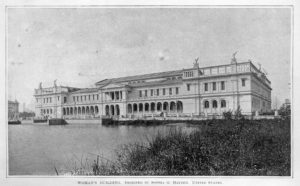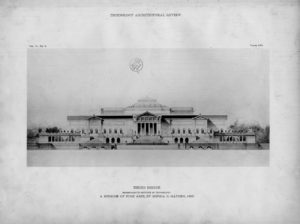
Amazing Artist
She was born in Santiago, Chile and grew up with her grandparents in Boston, Massachusetts. As a teenager, she fell in love with the architecture throughout her community, and followed her dream to become one of the first women to graduate with an architecture degree from MIT. She went on to win a major design contest for the 1893 World’s Columbian Exposition in Chicago. Step back to 1891 and meet Sophia Hayden Bennett …
Her Ruby Shoe Moment
The Power of the Wand
Her Yellow Brick Road
Brains, Heart & Courage
Glinda’s Gallery
Just the Facts
Her Ruby Shoe Moment
Sophia arrived in Chicago in the summer of 1891, eager to start on the architectural commission of a lifetime. She had won the design competition for the Woman’s Building at the 1893 World’s Columbian Exposition in Chicago. It was time to make her design a reality. And she was only 21 years old.
Shortly after Sophia arrived in Chicago, the Board of Lady Managers added some stipulations and requested a number of changes to her architectural plans. Sophia acquiesced to some changes, but pushed back on others. She was determined to fight for the integrity of her design.

The Woman’s Building
Specifically, the Board of Lady Managers requested a new third story to the entire building. Such a major change, however, required significant changes to the entire design. Sophia spent a significant amount of time revising many elements of the architectural drawings.
The Board of Lady Managers also required that the decorative elements of the building be created by women, regardless of whether they fit within the overall design. Sophia resisted, so the president of the Board of Lady Managers took over all the interior design of the entire building.
The Woman’s Building was the first building for the World’s Columbian Exposition to begin construction. Less than two years later, it was the first to be completed. It was an aggressive timeline, however, and the process was difficult on Sophia. The stress of the whole process affected Sophia’s health — it was rumored that she had a nervous breakdown and spent a few months in a “rest home” to recover.

Interior of Woman’s Building
The secretary to the Board of Lady Managers commented about Sophia: “It was generally known about the Construction Department that no one could change, by any amount of persuasion, one of her plans when she was convinced of its beauty or originality. She was always quiet but generally carried her point.”
October 21, 1892 was dedication day for the Woman’s Building at the World’s Columbian Exposition in Chicago. The, the Exposition opened in May of 1893. And it was a huge success. The Women’s Building was dedicated to showcasing the work of women. It included an exhibition hall, assembly rooms, libraries, and a Hall of Honor. And it contained a number of exhibits of fine art and crafts.
Sophia received an Artist’s Medal for her design of the Women’s Building from the Board of Directors of the Exposition, as well as a gold medal from the Board of Lady Managers. Sadly, Sophia’s building is no longer standing — most of the buildings from the World’s Columbian Exposition were considered temporary and demolished after it closed in November of 1893.
The Power of the Wand
Sophia’s architectural career was the victim of 19th century sexism — critics of the Woman’s Building couldn’t get past the fact that it was designed by a woman. They called it “dainty but tasteful” and “graceful timidity or gentleness” and “rather lyric than epic in character” and “with a certain modest grace or manner not inappropriate to its uses and to its authorship.”
Sophia was frustrated by her unfair treatment. As a result, her architectural career was very short. However, her perseverance in a man’s field paved the way for generations of women to pursue a career in architecture. When Sophia died in 1953, there were about 300 women architects in America. Today, about 20% of all architects in America are women.
Her Yellow Brick Road
In February of 1891, Sophia heard about an announcement for a competition to design the Pavilion of Women/Women’s Building for the 1893 World’s Columbian Exposition in Chicago. It was the first time an entire building would be devoted to women’s accomplishments. It was created for women by women — the design contest was only open to professional women architects and was overseen by a Board of Lady Managers.
 Sophia spent hours and hours drafting her design plans. Ideas swirled around in her head. She eventually pulled out her thesis project from her days at MIT — a fine arts museum in the Italian Renaissance style. It was the perfect springboard for her proposal for the Women’s Building. Her design featured pavilions in the middle and each end, as well as arches, columns and other classical features.
Sophia spent hours and hours drafting her design plans. Ideas swirled around in her head. She eventually pulled out her thesis project from her days at MIT — a fine arts museum in the Italian Renaissance style. It was the perfect springboard for her proposal for the Women’s Building. Her design featured pavilions in the middle and each end, as well as arches, columns and other classical features.
There were 13 proposals in total, including Sophia’s. She was one of the least experienced architect to submit a proposal, and didn’t expect to win. So she was completely surprised when she learned, on March 25, 1891, that her design was selected as the winner. The prize was $1,000, much less than the prizes available to men architects.
Sophia had only 2 years to make her design a reality. So she had to travel to Chicago at once.
Brains, Heart & Courage
Sophia was born in Santiago, Chile and had 4 siblings. Her mother, Elezena Fernandez, was Chilean. Her father, George Hayden, was an American. A dentist, he moved to Chile from his hometown of Boston.
Sophia’s parents wanted her to receive the best education possible. So they sent her to America to live with her grandparents when she was six years old. She lived in Jamaica Plain and attended West Roxbury High School.
 Sophia embraced all that Boston had to offer and became fascinated with the variety of architecture throughout the city. She wanted to go to college and study architecture, which was unusual for women at the time.
Sophia embraced all that Boston had to offer and became fascinated with the variety of architecture throughout the city. She wanted to go to college and study architecture, which was unusual for women at the time.
Sophia was admitted to the Massachusetts Institute of Technology in 1886 and threw herself into her studies. She did well and impressed her professors. Her senior thesis project was entitled “Renaissance Museum of Fine Arts.” She graduated in 1890 with honors, as one of the first women to earn a degree in architecture from MIT.
Despite her prestigious degree, however, she couldn’t get a job as an architect. At the time, the field was dominated by men, and she wasn’t taken seriously. The only job she could get is a teacher of mechanical drawing. So she worked at the Eliot School in Boston. It was a decent job. But then she learned of an opportunity that she could’t pass up.
Glinda’s Gallery
Just the Facts
- Sophia Gregoria Hayden was born in Santiago, Chile on October 17, 1868. Her mom, Elezena Fernandez, Her parents sent her to live with her grandparents in America.
- Sophia graduated from West Roxbury High School in 1886 and became the first woman to attend the architecture program at MIT.
- Sophia couldn’t find professional work as an architect so she became a technical drawing teacher at the Eliot School in Boston.
- Sophia won the design contest for the Women’s Building of the 893 World’s Columbian Exposition in Chicago. It was her only professional commission and likely the only one of her designs to be constructed.
- Sophia married William Blackstone Bennett in May of 1900. He was a portrait painter and interior designer. They had no children and lived in Winthrop, Massachusetts for the rest of Sophia’s life. She worked as an artist for the rest of her career.
- Sophia died on February 3, 1953 from pneumonia after suffering a stroke.
- Sophia’s gold medal for her design of the Women’s Building was auctioned for $16,000 in 2019.
Want to Know More?
Torre, Susan, ed. Women in American Architecture. NY: Whitney Library of Design, 1977.
Woman’s Building, Chicagology website (https://chicagology.com/columbiaexpo/fair013/)
Women’s History at the 1893 World’s Columbian Exposition, National Park Service website (https://www.nps.gov/articles/000/women-s-history-at-the-1893-world-s-columbian-exposition.htm)
World’s Fair Chicago, 1893 (https://worldsfairchicago1893.com/tag/womans-building/)
